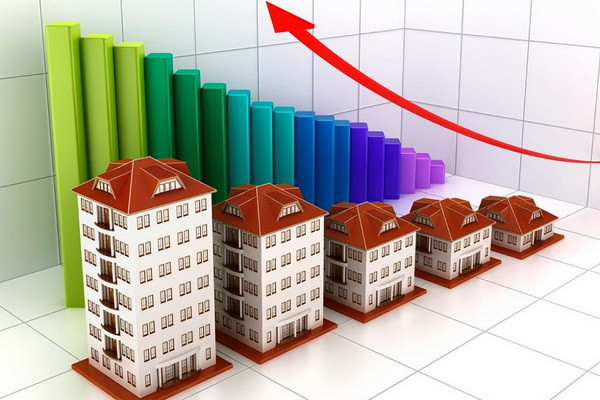
Rising demand for real estate in Uzbekistan
Tashkent, Uzbekistan (UzDaily.com) - About 76.6 thousand residential buildings were built in the Republic of Uzbekistan in 2021, which is 15.1 thousand units more than in 2020. This testifies to the effectiveness of the measures taken to expand housing construction on a large scale, including affordable residential buildings through the provision of mortgage loans on market principles.
The positive dynamics was facilitated by the sustainable development of the economy of Uzbekistan in recent years, accompanied by a significant increase in the income of the population, including through an increase in the volume of international money transfers, which amounted to US$8.1 billion in 2021, which is 34% more than in 2020 and 2019 (US$6.03 billion).
This, along with other factors, led to a significant increase in effective demand for comfortable housing, in connection with which the real estate market in Uzbekistan continues to grow positively. In 2021, the largest increase in real estate purchase and sale transactions was observed in Namangan (42.7%), Bukhara (38.2%), Andijan (33.8%), Samarkand (31.4%), Navoi (30.5%) %), Fergana (29.2%) and Surkhandarya (23.7%) regions.
The growth in the number of concluded sale and purchase agreements in the regional markets of "secondary" housing shows the relationship and comparability with the trends in price dynamics per square meter of housing. In 2021, the largest increase in prices for "secondary" housing was revealed in Namangan (31.7%), Syrdarya (30.8%), Surkhandarya (25.4%), Ferghana (21.5%) and Bukhara (17.0% ) areas.
On the "primary" real estate market, transactions are made with newly built apartments and houses. It should be noted that the analysis of changes in this market segment showed the multidirectional movement vectors of the average weighted prices of 1 sq. m of "primary" housing in 2021 in relation to 2020.
The weighted average price of 1 square meter of “primary” housing in Uzbekistan increased by 4.2% over the past year. A pronounced increase was found in the Republic of Karakalpakstan (15.9%), Bukhara (19.1%), Tashkent (14.7%) and Samarkand (11.3%) regions.
At the same time, prices in Jizzakh region and Tashkent city decreased by 6.0% and 0.3%, respectively. The minimum levels of growth were observed in Kashkadarya (2.0%), Fergana (2.1%) and Surkhandarya (2.4%) regions. In other regions, the cost of primary housing increased by 4.2-10.3%.
The study and analysis of the situation in many countries show that prices in the real estate markets continue to rise.
According to the report "Global House Price Index" of the international agency "Knight Frank’s", in 2021, house prices in annual terms increased by an average of 9.2% in 55 countries. At the same time, a third of the real estate markets recorded an increase in prices of more than 10% in annual terms.
The continuing increase in prices in the regions of Uzbekistan indicates that the positive dynamics of demand for housing is in line with the main trends in world markets.
Further development of housing construction in the country is carried out on the basis of various forms and mechanisms of state support and assistance in purchasing housing, which makes a significant contribution to the reduction of poverty and social inequality in the country.
In 2022, the construction of 22 Yangi Ozbekiston blocks with all amenities and the necessary social infrastructure (schools, kindergartens, medical institutions, consumer services and trade complexes) is underway. At the same time, new jobs are being created for residents of new areas, including the organization of small industrial zones and the implementation of various business projects.
In order to reduce the cost of housing, support this segment of construction and the population, a number of preferences and benefits have been introduced. This year, up to 13 trillion soums of targeted loans and 1.3 trillion soums of subsidies are allocated for the implementation of the mortgage construction program.
Also, a mechanism for allocating subsidies in the amount of 32 million soums to the low-income population for the payment of part of the initial contribution has been launched. The same rate for compensation by the state to the low-income population has been established for all regions - 10%. Subsidies will also be issued for loans received for the construction and repair of individual housing. 1 trillion will be allocated annually from the budget. sums to provide new arrays with internal and external infrastructure.
These measures create favorable conditions for providing the population with high-quality, comfortable housing through the rational use of market mechanisms, as well as state support. The solution to the problem of housing provision in the future is connected with the need to significantly increase the volume of construction and development of all elements of the infrastructure of cities and towns in Uzbekistan, while using progressive approaches to the construction of facilities.
Mirkhamid Turaev
Chief Research Fellow,
Institute for Forecasting and Macroeconomic Research
Khushnudbek Vasitov
Deputy Project Manager,
Institute for Forecasting and Macroeconomic Research